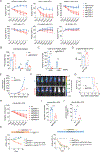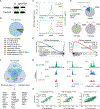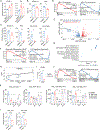KAT6A and ENL Form an Epigenetic Transcriptional Control Module to Drive Critical Leukemogenic Gene-Expression Programs
- PMID: 34853079
- PMCID: PMC8916037
- DOI: 10.1158/2159-8290.CD-20-1459
KAT6A and ENL Form an Epigenetic Transcriptional Control Module to Drive Critical Leukemogenic Gene-Expression Programs
Abstract
Epigenetic programs are dysregulated in acute myeloid leukemia (AML) and help enforce an oncogenic state of differentiation arrest. To identify key epigenetic regulators of AML cell fate, we performed a differentiation-focused CRISPR screen in AML cells. This screen identified the histone acetyltransferase KAT6A as a novel regulator of myeloid differentiation that drives critical leukemogenic gene-expression programs. We show that KAT6A is the initiator of a newly described transcriptional control module in which KAT6A-catalyzed promoter H3K9ac is bound by the acetyl-lysine reader ENL, which in turn cooperates with a network of chromatin factors to induce transcriptional elongation. Inhibition of KAT6A has strong anti-AML phenotypes in vitro and in vivo, suggesting that KAT6A small-molecule inhibitors could be of high therapeutic interest for mono-therapy or combinatorial differentiation-based treatment of AML.
Significance: AML is a poor-prognosis disease characterized by differentiation blockade. Through a cell-fate CRISPR screen, we identified KAT6A as a novel regulator of AML cell differentiation. Mechanistically, KAT6A cooperates with ENL in a "writer-reader" epigenetic transcriptional control module. These results uncover a new epigenetic dependency and therapeutic opportunity in AML. This article is highlighted in the In This Issue feature, p. 587.
©2021 American Association for Cancer Research.
Conflict of interest statement
Figures






References
Publication types
MeSH terms
Substances
Grants and funding
LinkOut - more resources
Full Text Sources
Other Literature Sources
Molecular Biology Databases
Research Materials

